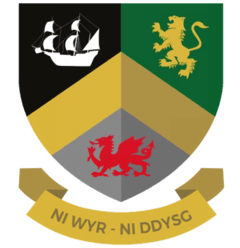Ysgol Uwchradd Caergybi
Ysgol Uwchradd Caergybi is a secondary school in Holyhead, Anglesey. It claims to be the first comprehensive school in England and Wales, opening in 1949 as Holyhead County School.[2]
| Ysgol Uwchradd Caergybi | |
|---|---|
 | |
| Address | |
Holyhead LL65 1NP | |
| Coordinates | 53°18′41″N 4°38′23″W |
| Information | |
| Established | 1949[1] |
| Local authority | Isle of Anglesey |
| Headteacher: | Adam Williams (2013 – present) |
| Assistant Headteachers: | Nia Wyn Roberts Peter Nutbourne Marion Sterrit Stella Dennis-Bunting |
| Staff | 70 (Approx.) |
| Gender | mixed |
| Enrolment | 874 |
| Sixth form | c. 100 |
| Website | http://www.ysgoluwchraddcaergybi.cymru/ |
History
The school was formed in 1949 with the amalgamation of Holyhead Grammar and St Cybi Secondary school. Ysgol Syr Thomas Jones, Amlwch is said to claim the title of the first purpose built comprehensive.[3] Ysgol Gyfun Llangefni is recorded as the UK's first comprehensive.[2]
There was a number of reasons for the school to be the first "comp". The headmaster Mr Hughes was retiring and he was to be replaced by an enthusiast for Comprehensive education, Trefor Lovett. The new head became known as "the first apostle of the comprehensive movement."[4] The transition was also assisted by the close proximity of St Cybi Secondary school and Holyhead Grammar; the schools that would be replaced. Obviously the backing of Anglesey Education Committee was essential.
The changes that Lovett brought about were not unexpected as he has previous taught locally at Vaynor and Penderyn schools. The new school was certain that a child's future should not be determined at age eleven with the eleven plus exam. Previously children in Wales had all sat an exam at the end of their junior school education and this decided whether they would attend the grammar school or a secondary modern school. Lovett was convinced that this was unfair and that there should be a firm catchment area so that all the students irrespective of their background or abilities would attend the one school.[4]
After two years, the new head reported,
The school is rapidly approaching my concept of what a comprehensive school should be. On the grammar side, the facilities are good. The technical side is also rapidly developing and with the erection and equipping of the new engineering workshop the facilities or this type of education will be good. We have a large number of pupils of the modern school type and a real effort is being made to give them an education suitable to their aptitudes and abilities. Work of a far more practical nature must be introduced for these pupils and this demands further expansion in providing the requisite facilities and staff.[4]
The school today
In 2006 there were approximately 850 pupils in the school which included about 100 in the sixth form.[5] The school had falling rolls in the years before and is much reduced since there were questions in the early 1960s in the House of Commons to then Education Minister Chris Chataway enquiring how the school was to cope with a roll of 1400 pupils.[6] In 2010 the school has exceeded the local authority's projected figures.[7]
Twelve per cent of the students are able to speak Welsh fluently and four per cent have Welsh as their first language. The catchment area of the school is mainly the town of Holyhead and the area around the school has been highlighted as an area for development with nearly 30% of households having no wage earner. Estyn visited the school in 2008 and commended the school with regards to teaching and pupil behaviour.[5]
Five years ago the school moved its sixth form out of the old red brick Cybi building and put that in the control of the local authority. Since then the building has become dilapidated and the education authority announced in 2008 it intended to demolish the building. The building was still standing as of 2012. As a result of the intervention of local county councillor, Robert Llewelyn Jones, CADW has given the façade a Grade 2 listing. This listing has prevented the local authority from continuing with its demolition plans and the site is now earmarked for a new super-primary school (subject to funding being available).
At present virtually all pupils in the Ysgol Uwchradd Caergybi catchment area choose the school for their secondary education. The school's pupil numbers continues to rise and recent significant funding towards a new canteen/refrectory and technology block has succeeded in improving the school's facilities dramatically.
Notable former pupils
of the comprehensive
- Glenys Kinnock, politician [8]
- Tracey Morris, athlete [9]
- Albert Owen, politician[10]
- Tony Roberts, Former Welsh International and QPR goalkeeper[11]
- Dawn French, comedian/actress
of predecessor schools
References
- (Correction to) How the Tory middle classes invented comprehensives, Simon Hoggart, The Guardian, 28 June 2007, accessed 12 August 2008
- "Ten Questions". The Independent. 25 October 2005. Archived from the original on 28 April 2009. Retrieved 12 August 2008.
- First comprehensive, New Shell Book of Firsts, 2003
- Holyhead County School Archived 28 August 2008 at the Wayback Machine, Holyhead.com, accessed 12 August 2008
- 2006 Inspection of the school by Estyn, accessed 12 August 2008
- Hansard, 22 November 1962
- Holyhead School to be Demolished, Daily Post, 24 July 2008, accessed 12 August 2008
- Glenys Kinnock MEP website. "Glenys Kinnock Biography". Retrieved 12 August 2008.
- BBC. "Tracey Morris biography". Retrieved 27 September 2008.
- Albert Owen biography, Guardian, accessed 12 August 2008
- BBC. "QPR honours Holyhead hero". Retrieved 12 August 2008.
- ‘CLEDWYN OF PENRHOS’, Who Was Who, A & C Black, 1920–2007; online edn, Oxford University Press, Dec 2007 accessed 22 Aug 2008
- ‘WILLIAMS, David’, Who Was Who, A & C Black, 1920–2007; online edn, Oxford University Press, Dec 2007 accessed 22 Aug 2008